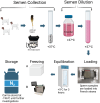Extender development for optimal cryopreservation of buck sperm to increase reproductive efficiency of goats
- PMID: 40241808
- PMCID: PMC12001040
- DOI: 10.3389/fvets.2025.1554771
Extender development for optimal cryopreservation of buck sperm to increase reproductive efficiency of goats
Abstract
Preservation of sperm significantly contributes to the advancement of assisted reproductive technologies, genetic conservation and improvement efforts, and precision breeding of livestock. This review distills knowledge from the existing information and emerging patterns in the field of buck sperm cryopreservation. The primary focus is on the challenges and opportunities associated with improving extender formulations and freezing techniques in order to enhance the vitality of sperm after thawing and to increase the potential for conception. This review assesses the efficacy and limitations of conventional extenders derived from egg yolk or soybean lecithin, and the adverse impacts of seminal plasma enzymes on sperm quality during the processes of chilling and cryopreservation. Significant progress has been made in the fields of molecular biology namely lipidomics, proteomics, metabolomics, DNA methylation providing valuable knowledge regarding the unique reactions of sperm to cryopreservation. The utilization of the "omics" technologies has shown intricate molecular transformation that occur in sperm during freezing and thawing. Moreover, detection of molecular biomarkers that indicate the quality of sperm and their ability to withstand freezing provides opportunities to choose the best sperm samples for cryopreservation. This, in turn, enhances the results of artificial insemination and genetic conservation endeavors. This review emphasizes the necessity for adopting a comprehensive approach that combines molecular and cellular knowledge with practical methods in the field of sperm cryopreservation to ensure production of goats as major food animals in the global scale.
Keywords: antioxidants; cryopreservation; extender; omics; sperm; sustainable goat production.
Copyright © 2025 Bodu, Hitit, Greenwood, Murray and Memili.
Conflict of interest statement
The authors declare that the research was conducted in the absence of any commercial or financial relationships that could be construed as a potential conflict of interest.
Figures


Similar articles
-
Cryopreservation and egg yolk extender components modify the interaction between seminal plasma proteins and the sperm surface.Theriogenology. 2019 Dec;140:153-163. doi: 10.1016/j.theriogenology.2019.08.025. Epub 2019 Aug 22. Theriogenology. 2019. PMID: 31473498
-
Effects of adding egg yolks of different avian species to Tris glycerol extender on the post-thawing quality of buck semen.Anim Reprod Sci. 2018 Aug;195:345-354. doi: 10.1016/j.anireprosci.2018.06.016. Epub 2018 Jun 25. Anim Reprod Sci. 2018. PMID: 31262406
-
Cryopreservation of dog semen in a Tris extender with two different 1% soybean preparations compared with a Tris egg yolk extender.Vet Med Sci. 2021 May;7(3):812-819. doi: 10.1002/vms3.445. Epub 2021 Feb 11. Vet Med Sci. 2021. PMID: 33570263 Free PMC article.
-
Cryopreservation of bull semen: Evolution from egg yolk based to soybean based extenders.Anim Reprod Sci. 2016 Sep;172:1-9. doi: 10.1016/j.anireprosci.2016.04.013. Epub 2016 May 3. Anim Reprod Sci. 2016. PMID: 27509873 Review.
-
Cryopreservation of domestic animal sperm cells.Cell Tissue Bank. 2009 Feb;10(1):49-62. doi: 10.1007/s10561-008-9081-4. Epub 2008 Jun 12. Cell Tissue Bank. 2009. PMID: 18548333 Review.
Cited by
-
Lipidomic Landscapes of Cryopreserved Sperm from Alpine and Spanish-Creole Bucks.Animals (Basel). 2025 Jun 27;15(13):1897. doi: 10.3390/ani15131897. Animals (Basel). 2025. PMID: 40646797 Free PMC article.
References
-
- Monteiro AC, Lima MJ, Costa JM. Goat system productions: advantages and disadvantages to the animal, environment and farmer. In:Kukovics S, editor. Goat Science. Rijeka: IntechOpen; (2017). p. 351–66.
-
- Aziz MA. Present status of the world goat populations and their productivity. Lohmann Inform. (2010) 45:42–52.
-
- Sinn R, Rudenberg PG. Raising Goats for Milk and Meat. Arkansas: Heifer Project International; (1983).
-
- Hirst K. The History of the Domestication of Goats (Capra Hircus). New York, NY: Dotdash Meredith, Thought Co., (2019).
-
- FAO . Fao Statistical Yearbook 2023. Rome: Food and Agriculture Organization of the United Nations; (2023). 10.4060/cc8166en - DOI
Publication types
LinkOut - more resources
Full Text Sources

